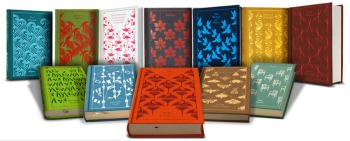Books can be truly beautiful objects. Having recently completed a postgraduate degree in publishing studies and learned a lot about the design and production process, I appreciate this all the more. Take the Penguin Classics hardback series, for example. Designed by Coralie Bickford-Smith, these linen covers have been stamped with beautiful, vibrant and colourful depictions of images representing the novels they enclose. They will make a wonderful edition to any book lover’s collection.

I want all of them. No, really. ALL of them. Even Pride and Prejudice. (Sorry, Austen fans, I’m a Brontë girl). © Penguin Books.
Paperbacks can also be beautifully designed, and many of them are. As a great example, you should check out the book trailer for the illustrated version of A Monster Calls by Patrick Ness, which provides an awesome preview of the artwork in both the hardback and paperback editions.
In my experience, people who love reading paperbacks often fall into two distinct categories: the spine-benders and the spine-preservers. The former bend the spines of their books while reading them; the latter make sure to keep their book spines intact and looking like new. I have a confession to make. My name is Jo, and I’m a spine-bender. It seems to be an inherited trait. My mother is a spine-bender too, and, since I got my love of reading from her, it seems only natural that I would follow her manner of reading as well. This habit of mine has horrified some of my spine-preserver friends. Whenever I borrow a book from one of them, I make sure to leave the spine untouched. If I accidentally slip back into my spine-bending ways, which has happened once or twice, I buy them a brand new copy. After all, to us bibliophiles our books are precious objects, and, when borrowed, should be treated with respect. Or else.
So, if I love books so much, why would I intentionally damage them? One reason is I genuinely find them easier and more comfortable to read if I can open them out properly; but there is a more meaningful reason than that. When I first pick up a book in a bookshop, I see a world of possibilities. Will I love this book? Will I hate it? Will it have a profound effect on me, or will it leave no impression at all? When you pick up a book from my collection, you’ll probably be able to answer those questions. Like most book lovers, I can’t fit all of them onto one shelf, or even into one bookcase. Instead, a small selection of my favourites sit on a special shelf in my bedroom where I can see them every day.
With a glance, you can tell which ones I’ve read the most – their spines are seriously creased. If you pick one of them up, Book One of the Banned and the Banished series by James Clemens, for example, it will look a little worn, the pages a little ragged. You might even find a piece of paper or two tucked between the pages containing my thoughts and feelings about particular passages. Maybe some old index tab stickers leftover from my university days will draw your attention to a quote that I thought was important or meaningful. The book itself might help you learn still more about my reading habits by simply falling open at a particular page; one I’ve read so many times that the spine has completely cracked.
If you’re looking for the book that means the most to me, you won’t find it on this shelf. It has lived in the top drawer of my bedside table ever since I first got it in 1996, at the tender age of nine. As you can see, it’s pretty beaten up. It looks like it’s been read dozens of times and travelled with me to many places. It has. When I look at its curling pages, its creased cover and worn spine, I don’t see a book which has been poorly cared for. I see a book that has a history, a unique character that sets it apart from the untouched copies in a bookshop. I see the times it has given me comfort. Made me laugh. Made me think. Made me cry. Even just holding it makes me feel better.

My eighteen-year long love affair with Star Trek and why it means so much to me is a whole other story. I might write about that another time.
I have nothing against the development of e-books. I understand their advantages and that they can lead more people to a love of reading. To me, though, they’re nothing more than data files. Other than the words they contain, they have no character. They remain the same no matter how many times they are read. They can’t absorb the ink of an author’s autograph or a message from a loved one. You can’t hold them in your hands, only the device they have been downloaded onto. And, the most important drawback for me – you can’t put them on a bookshelf. These limitations don’t matter to everyone, but they matter to me.
That being said, if a book I really wanted to read was only available in digital format, I would still read it. I wouldn’t deny myself that book just because it was in a format other than paper and ink. I don’t agree with the idea I’ve heard flaunted by some literature snobs that those who only read e-books are not ‘real readers’. That’s nonsense. Of course they are. Whether for convenience, financial reasons or the attraction of interactive features, for some people e-books are their preferred way of reading. For me, though, the way I interact with a book is inextricably linked to the format in which I read it. In my case, that means paper and ink all the way. I don’t mind if that means my suitcase is a little heavier when I travel. I don’t care that the book costs a bit more or that it might take longer to get to me. Those extra little hassles are more than worth it for the reading experience I love.
I’m actually dealing with one of those hassles right now. The release date for a Star Trek novel I’ve been waiting fifteen months for has been pushed back by two weeks. The release date for the paperback, that is. The e-book is readily available now. I could have it in about five minutes via my Google Books app for £4.99 if I was so inclined. I’m not. Sure, it’s frustrating to have to wait for longer, but I’ve already waited fifteen months, so what’s another few weeks if I know I’ll enjoy the reading experience more if I just have a little patience?
In the Star Trek universe, set in the 23rd and 24th centuries, for all their advanced technology, the characters are often seen reading from physical books as well as from data pads. The two exist side by side. That’s how it should be. Unfortunately, publishing in both print and digital formats isn’t always financially feasible these days.

Captain Picard often had his nose in a traditional book, particularly the works of Shakespeare. © Paramount Studios.
Some might say that I haven’t given e-books a fair chance. That may be true. I’ve never read an e-book from start to finish. I got about halfway through one of the free downloads that came with my Google Books app before I gave up. I just wasn’t enjoying the reading experience; which in turn meant I wasn’t enjoying the book as much either. The app came already installed on my smart phone, otherwise I probably wouldn’t have bothered with it. I borrowed my uncle’s Kindle last year and tried to read a book on that. Same problem. E-books just aren’t my thing.
Does this mean that I’m a hopelessly out of touch fuddy-duddy who has no business going after a job in the increasingly digitised world of publishing? No, I don’t think so. The field I’m most interested in is academic/educational publishing, and I’m really enthusiastic about new forms of scholarly publication like open access journals. I may not like e-books when I’m reading for pleasure, but online resources and digitally published research articles were invaluable to me while I was at university. I would love to be involved with academic publishing and help to promote information sharing in the digital age. Similarly, if I was able to work with a fiction publisher, I would be just as dedicated to producing high quality e-books as I would be to physical books. Just because I’m personally not keen on reading them, doesn’t mean I have anything against others doing so, especially if access to e-books encourages people to read more.
Whichever branch of the publishing industry I find myself in, I will gladly go to work each day ready to enthusiastically launch myself into any project I’m asked to. But when I go home, and curl up by the fire in an old armchair in the house I hope to have one day, it’ll be with a physical book. Be it one of my old creased companions, or a new friend waiting to be etched with my memories.



I used to be a Spine-Bender, especially with a few of my copies of the Harry Potter books. Now, however, I try to be more careful with my paperbacks. Of course, with my hardcovers, if the book jacket gets a single bend in it, I’m thrown into a hysterical frenzy, haha!
I’m actually the same way with hardbacks, although I don’t read a lot of them. I tend to take the book jacket off and put it somewhere safe so it doesn’t get damaged while I’m reading it, which seems odd considering what I do to paperbacks! Thanks for commenting. 🙂
Pingback: The Book Blogger Test | Drifting Pages
Pingback: Liebster Blog Award (2) | Drifting Pages
Pingback: Sisterhood of the World Bloggers Award | Drifting Pages